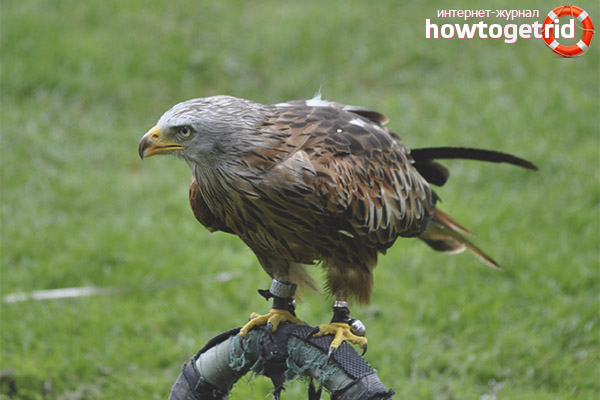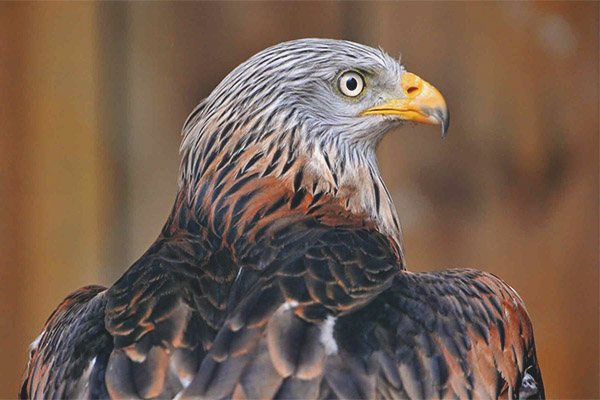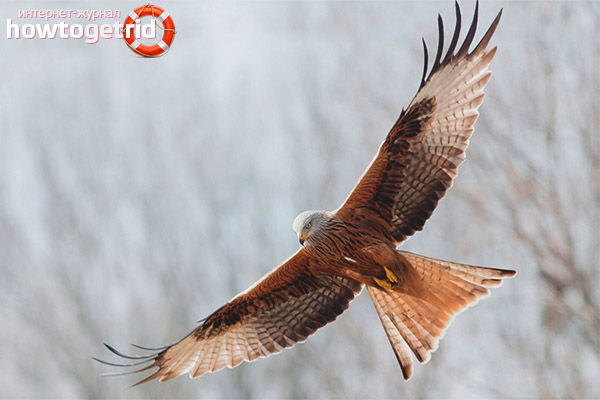The content of the article
Red kite looks very impressive. In flight, they are especially elegant. In order not to spend a lot of effort on maintaining height, kites use air flow. They do not fly fast, but they are able to stay in the air for quite a long time. They belong to the hawk family.
Appearance
- The body of the male is about 56-61 cm long. The females are 5% larger. The wingspan is up to 165 cm. The male weighs on average 850-1250 g, the female weighs 150-200 g more.
- The red kite has very long primary feathers. They are located so that the bird can control the flight. The wings are narrow, slightly curved back.
- These birds have excellent eyesight. They see about 8 times better than people.
- Beak, like other predators, sharp, curved. It allows you to easily carve carrion or a living victim.
- Claws are not very large, but sharp.
- The tail is long, has a pronounced recess.During the flight, the kite uses it as a steering wheel.
- The female lays about 2-3 eggs. Sometimes they can be 1 or 4. They are painted white, stained.
- The upper plumage of these birds is brown, the head is lighter. Bottom body covered with brown plumage, but a lighter shade than the top. In flight, this bird can be distinguished by narrow wings that are somewhat curved backwards, as well as along the long tail.
Habitat
You can see the red kite almost throughout Europe. Most of them in France, Spain. To date, the number in southern Europe has rapidly declined.
This species is recognized as one of the most beautiful among all birds of prey. Due to the structure of the wings, it floats beautifully in the air, keeps balance, using its tail for control. About 50% of the total population lives in Central Europe. This is approximately 5,000 pairs of kites.
Nutrition
Previously, they ate only different mammals, invertebrates, fish. But today they lack this food. Therefore, kites are forced to eat leftover food thrown into landfill by humans. Sometimes their victims are birds. In severe frosts, when it is impossible to get other food, they eat the carrion that they come across. These can be hares or other forest mammals.
Due to their endurance, they can fly at high altitudes for several hours, looking for prey. They usually hover on 20-30 m from the ground. As soon as the kite sees a suitable sacrifice, he immediately rushes down, grabbing it with claws. However, he may not even land. Grabbing the prey, he can immediately take off with her. Their claws are not very developed, but they are quite suitable to kill a small animal.
Lifestyle
These birds are kept in pairs. They live about 4-5 years. But there are cases when the bird can even live to 26. The black kite is a related species, in some parts of Europe it displaces red.
The size of the species is similar to the size of the buzzard.But its structure is much more elegant. Individuals living in the south of Sweden and England are sedentary. And those who live in central Europe are migratory. In the winter they fly to the south of France and Portugal. To their nesting places fly away at the very end of winter. In winter, they live in packs. Together they are looking for food and spend the night together.
Breeding
Their nesting period begins in April. From 1 to 4 eggs are laid, but most often there are 2-3 of them. Chicks appear in a month. After that, they still need care for 1.5-2 months. Puberty is reached at the age of 3 years.
Mating occurs in the second half of March or in early April. They perform a difficult mating flight. Build nests in the trees, most often having them at the edge of the forest. Marital flight begins with the fact that they circle above the tree on which the nest is located. After that, a pair of claws interlock with each other and quickly falls down. They spread their wings and tumble in the air. As they approach the treetops, they begin to rise again. Then all the actions of the pair are repeated again.
Steam nest equips together.It can reach about 1 m in diameter. They have it as high as possible. In general, the female is engaged in incubation. The male can replace it only occasionally. Nestlings can be different in color. Their shades range from almost white to brown. Parents take care of chicks for about 50 days, after which they fly away.
Human influence
The habitat of this species is found only in Europe, as well as the north-western part of the African continent. This species suffered a lot of testing. In the 16th-17th century, the red kites were simply “scavengers.” In the period from the 18th to the 20th century, the species was almost destroyed. These birds were caught to make them stuffed.
Later, the red kites completely disappeared from Scotland. From the beginning of the 20th century, they were under protection in the UK. In modern Wales, there are only about 10 pairs left.
Observations

See this bird most often in open areas. These are various fields and forest outskirts. On the territory of Central Europe, they also live among the hills. Use the air currents that occur among the slopes to soar for a long time in the air.They build a nest in forests, most often deciduous, sometimes mixed. This species is less dependent on water than a black kite. Birds become very shy during nesting. If during the arrangement of the nest next to the path will be a man, you can scare away the birds. It so happens that a frightened pair of birds will fly away from this place forever.
Scientists assume that today there are almost 4.5 thousand pairs of birds of this species living on the territory of Germany, there are about 300 of them on the territory of Poland, in Switzerland there are only about 200 pairs. And in Belgium and Holland, representatives of this species are almost nonexistent.
Interesting Facts
- In the days when Shakespeare worked, these birds were just “scavengers”. They were very much in the cities, including in London. This attracted the attention of people who came to the country. The Winter Fairy Tale describes how kites took off their linen, which the residents dried on the ropes, and used it to build a nest.
- Kites use their ability to maneuver in flight to select prey caught by other birds. They take food from rooks and crows.Sometimes they can pick up prey from a hawk or buzzard. If he meets a bird of prey in the air with prey, he begins to pursue it, waiting for her to release it. At this moment he grabs her and flies away as far as possible.
- In London, a representative of this species was seen in 1859. After that, the red kite was not seen in this city.
Protection and security
On the territory of Central Europe, the number is not reduced. But all the same face the threat of extinction. This is due to the fact that in many habitats the species is supplanted by the black kite.












To send